May 28, 2025 | 11:56 GMT +7
May 28, 2025 | 11:56 GMT +7
Hotline: 0913.378.918
May 28, 2025 | 11:56 GMT +7
Hotline: 0913.378.918
Mr. Nguyen Ngoc Dao, Chairman of Song Kon Forestry Company Limited in Vinh Thanh District, Binh Dinh, who has worked in the agricultural sector since 1995, strongly believed that planting large timber forests is not out of the farmers' reach. Furthermore, large timber forests can bring great benefits.
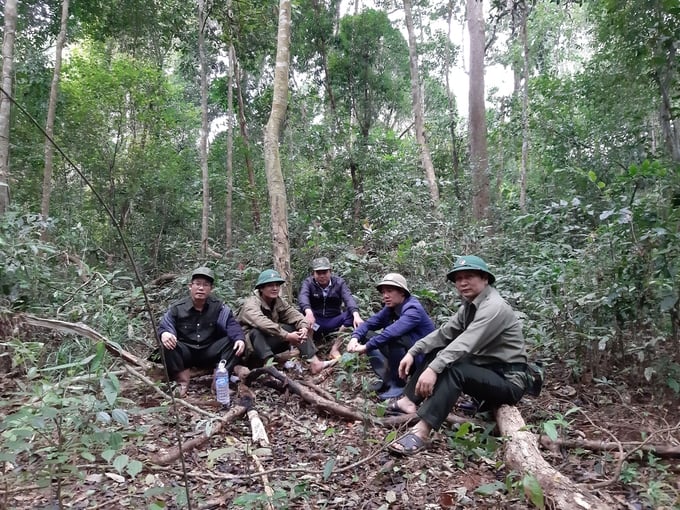
Mr. Nguyen Ngoc Dao, Chairman of Song Kon Forestry Company Limited in Vinh Thanh District, Binh Dinh, on a forest inspection trip. Photo: V.D.T.
According to Mr. Dao, the first prerequisite to planting a large timber forest is the selection of a good land area. Land with great potential for planting timber forests must have a thick layer of soil so that roots can grow and nurture the trees. Most businesses that want to plant large timber forests have a technical team to perform soil analysis. On the other hand, farmers afforestation land is fragmented, and they lack the technical aspects to perform similar analysis on the soil.
Mr. Dao shared his story: “Anyone who wishes to plant a new large timber forest on their own land can look at the surrounding planted forest areas. If the planted forest is 4 years old and the diameter of the trees is over 8cm, this means that the trees grow in height by 2cm per year; that is the land with great potential for timber plantation. Because if forest trees can grow by 2cm in diameter every year, then the area must have a thick layer of soil, and the roots have the conditions to grow deep into the soil as well as limit uprooting due to storms and rain; resulting in a strongly developed timber forest. Regarding previously planted forest areas, farmers can apply a similar experience when converting into a large timber forests: if your forest has been planted for 4 years and the tree has a diameter of over 8cm, it is safe to develop into a large timber forest.
According to Mr. Dao, farmers must pay attention to planting density when planting new large timber forests. The Ministry of Agriculture and Rural Development recommends the planting density to be limited to only 1,300 trees/hectare; if farmers plant at a density of 2,000 trees/hectare, they must trim it down. However, due to practical conditions in the Central region, farmers are recommended to plant at a density of 2,000 trees/hectare, to prevent seedling from dying due to harsh weather conditions.
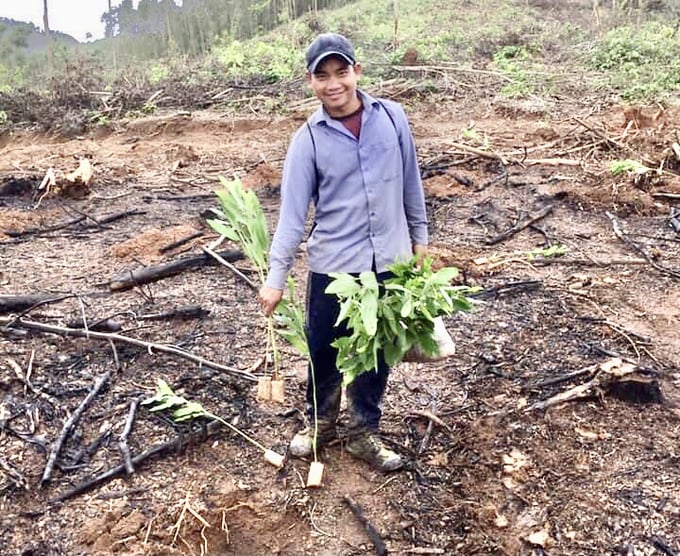
Planting large timber forests requires a deep soil layer for the roots to develop, helping the trees to develop strongly and give high yields. Photo: V.D.T
The planting duration must also be flexible. For exampl for mountainous districts bordering the Central Highlands in Binh Dinh such as Vinh Thanh, An Lao, Hoai An and Van Canh districts, the planting season should be early. Namely, there is often rains and storms after the Lunar New Year at around May and June, so forests will have the excellent conditions to develop strongly during this time frame. Conversely, the cold weather from September to October will be unsuitable for the growth of large timber forests. Most notably, acacia trees produce fungi when planted in the cold so their growth will be adversely affected. On the other hand, the plains will be affected by rains starting from August; farmers can start planting trees as soon as the rain seeps into the soil. Once the rainy season ends, the cold weather will severly impact afforestation.
“Farmers are used to planting 1 variety over and over again, so now it is necessary to use new varieties in order to avoid forest trees being infected with diseases caused by degraded varieties. There are varieties that grow very quickly in the early stages, and then slower towards the later stages. There are also varieties that grow slowly at first, but quickly pick up the pace afterwards. Therefore, large timber forests needs to be planted in mixed groups of different varieties, allowing for different speed of growths according to each variety. Farmers need to avoid mixing varieties with one another, to avoid the fast growing varieties in the early stages overwhelm the slow growing varieties, causing the forest to grow unevenly. Planting forests in mixed groups also helps prevent diseases for forest trees", said Mr. Nguyen Ngoc Dao.
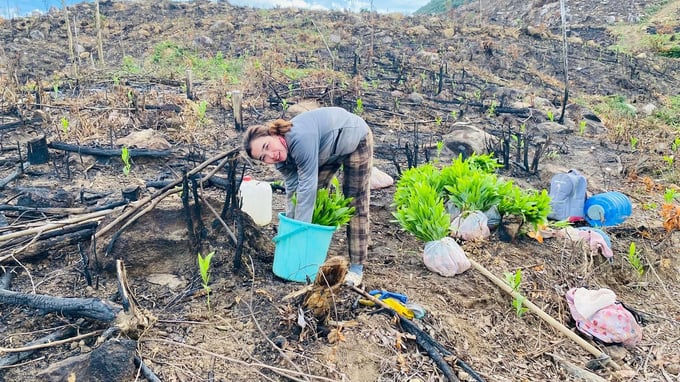
The planting season needs to be flexible depending on the land to avoid cold, and slow growth of forest trees. Photo: V.D.T.
Forest growers have to face the shortage of labor when it comes to the cycle of harvesting and replanting the forest. The denser the industrial zone grows, the less rural labor will be available. This is due to the fact that most of the young people in the villages are recruited to work at companies and factories, leaving only the middle-aged and the elderly available at home. The process of afforestation requires heavy works such as digging holes and transporting seedlings; Forest exploitation requires bark peeling and transporting timber onto vehicles. These are very arduous tasks that only young people can perform. Planted forests were only exploited after 5 to 6 years in the past; because the current price of planted timber has increased to 1.7 million VND/ton, newly planted forests are exploited after only 3 years. The denser the exploitation density, the more workers it attracts. Therefore, the labor pay in the forest profession is rising strongly, but still workers remain scarce.
Mr. Cu Van Man, who currently has nearly 100 hectares of commercial acacia forest in Phuoc Thanh commune, Tuy Phuoc district, Binh Dinh, claimed: "Forest workers are now mainly contracted, depending on where the forest is located: plains or high mountains, easy or difficult to exploit, easy or hard to peel, forest growers have to pay from 200,000 to 400,000 VND/ton to the workers.
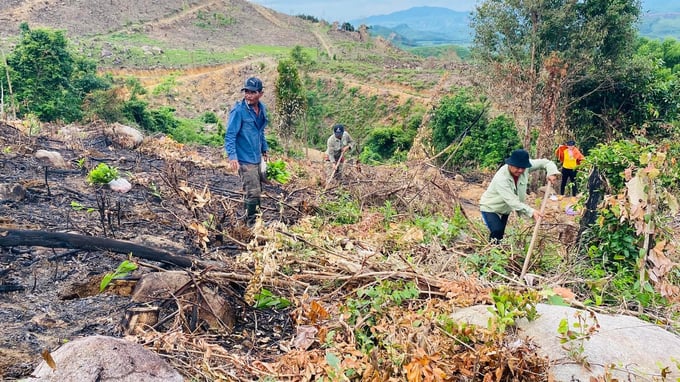
Digging holes for afforestation requires substantial labor, it's time to consider the mechanization of afforestation. Photo: V.D.T
According to Mr. Nguyen Ngoc Dao, Chairman of Song Kon Forestry Company, it is time to consider the mechanization of afforestation. Namely, digging holes requires substantial labor, and more importantly, planting large timber forests requires special drilling equipment in order to reach the desired depth. Many forest owners in Binh Dinh province utilize excavators to dig holes. The mechanization of digging costs more compared to manual digging, but in return, the trees will develop strongly with less care needed and high yield. "If we use a drilling machine to plant forests, the roots of forest trees will penetrate deeply into the soil, the trees will grow steadily as a result; the tree will not be uprooted even in stormy weather", said Mr. Dao.
When it comes to planting large timber forests, farmers voice their concerns: "The Central Region is affected by rainy and stormy weather regularly; large timber forests take 8 to 10 years before we can exploit, so we are afraid that the trees might not be able to withstand the rains and storms". However, according to Mr. Dao's experience, the acacia tree is extremely resilient. Even when they are knocked down close to the ground by the wind, the trees would still be able to grow upright afterwards because the acacia tree is drawn to light.
“Four years ago, hundreds of hectares of the company's forest in Hoai An district was knocked down by a storm; many trees were broken, we thought that this forest was a loss and the damage was at least 30%. This forest has since stood upright, the trees are only 7 years old, and the yield is estimated at 160 tons/hectare. Only when the forest is hit by a tornado would the trees be uprooted, but this is a rare occurrence. When the trees fall, they will all get upright eventually", said Mr. Nguyen Ngoc Dao.
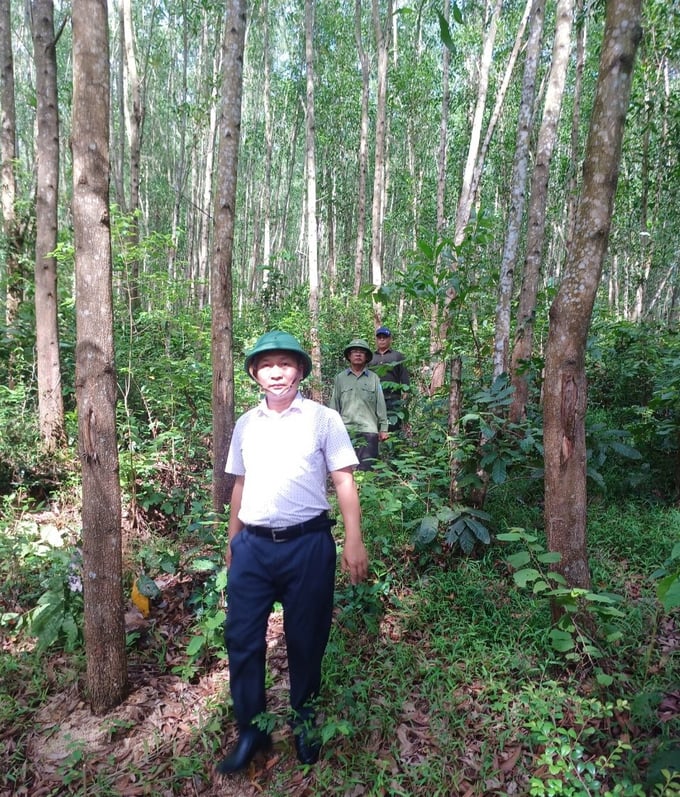
Mr. Nguyen Ngoc Dao (white shirt) visiting the company's large timber forest. Photo: V.D.T.
According to Mr. Dao, the planted trees start giving biomass from their third year onwards, and the growth rate will increase gradually for every subsequent year. In the 6th year, the yield is estimated to reach 120 tons/hectare; in the 7th year the productivity will increase to 160 tons/hectare, and in the 8th year, the productivity will increase to 180 tons/hectare.
“In the 3rd and 4th year, the yield is estimated at 60 tons/hectare, and the current average selling price is 1.5 million/ton, so 1 hectare of forest only yields 90 million VND in profit. After deducting the costs for exploitation, transportation, and digging holes for replanting, the profit for forest growers is marginal. By the 8th year, the yield will reach 180 tons/hectare. At that time, the size of the forest trees will be large enough to be used in the processing of wooden furniture for export, and the selling price will increase by at least 30%, so forest growers can benefit greatly", analyzed Mr. Nguyen Ngoc Dao.
Translated by Nguyen Hai Long

(VAN) FAO’s Director-General addresses the 5th Baghdad International Water Conference.
/2025/05/26/1716-4-nongnghiep-191706.jpg)
(VAN) Chain linkages, technological innovation, and raw material zoning are three strategic pillars for the coconut industry to strongly develop and elevate its position on the global agricultural map.
![Advanced mariculture – an inevitable trend: [4] Accompanied by scientists](https://t.ex-cdn.com/nongnghiepmoitruong.vn/608w/files/sohk/2025/05/13/1941-pgsts-vo-van-nha-140958_717.jpg)
(VAN) According to Assoc. Prof. Dr. Vo Van Nha, Director of the RIA III, the development of advanced offshore mariculture is no longer an option but an essential path for Vietnam’s fisheries sector.

(VAN) Vietnam is intensifying the development of mollusk farming areas that meet international standards, aiming for sustainable growth and enhancing its export position in the global seafood market.
![Advanced mariculture – an inevitable trend: [3] Policy-driven momentum](https://t.ex-cdn.com/nongnghiepmoitruong.vn/608w/files/doanhtq/2025/05/21/0104-0616-0348-nuoi-bien-170339_789.jpg)
(VAN) To ensure the success of offshore mariculture that uses advanced technologies, it is essential to establish supportive policies that inspire both individuals and enterprises to invest with confidence.
![Advanced mariculture – an inevitable trend: [2] Outstanding results](https://t.ex-cdn.com/nongnghiepmoitruong.vn/608w/files/sohk/2025/05/12/4632-4136-nuoi-bien-11-164117_819.jpg)
(VAN) Pilot models of high-tech offshore mariculture in Vietnam, particularly in the South Central Coast region, have demonstrated exceptional economic returns and sustainability, setting a new direction for the country’s aquaculture industry.
![Advanced mariculture – an inevitable trend: [1] Moving offshore](https://t.ex-cdn.com/nongnghiepmoitruong.vn/608w/files/phucpm/2025/05/18/0252-2436-nuoi-bien-6-162148_783.jpg)
(VAN) Mariculture using advanced technology and moving offshore is an inevitable trend, as nearshore areas increasingly reveal limitations.